
The Salon du Tapis d'Orient is a moderated discussion group in the manner of the 19th century salon devoted to oriental rugs and textiles and all aspects of their appreciation. Please include your full name and e-mail address in your posting.
by Patrick Weiler
Get out of the way, Gucci, here come the chanteh!

For an all-inclusive, definitive, comprehensive, complete definition of the term chanteh, you can reference The Oriental Rug Lexicon, by Peter Stone. His entry says: "bag or pouch". I do not recommend buying this book if all you need is the definition of chanteh.
Most people would say, "What is a chanteh, anyway?" This first piece, Qashqa'i, 19th century, is a case in point. It was advertised a couple of years ago on eBay as a "Carpet Piece, used as a doily". This exciting description probably explained the lack of bidders and its place as the Cheapest Chanteh in my collection. It is, however, also the finest and probably the oldest.

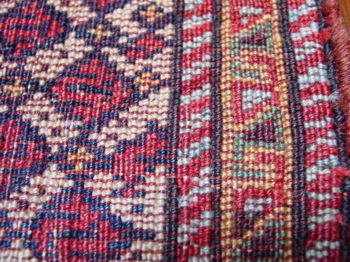
It is 11" wide by 10" high, with light brown z2s warps and two shots of red wool wefts. The pile
is 10h x 12v for 120 kpsi asymmetric open left, with some symmetric knots along the selvage, which is a bundle
of 4 warps overcast with maroon wool. The "Qashqa'i Frieze" ends are blue wool and white cotton complementary-weft
weave. There are 9 colors, including "a distinctive mustard, a mid-green, azure and pink" as Jenny Housego
described a Qashqa'i rug in Tribal Rugs (plate 100).
The design is common in Qashqa'i bags, as evidenced by a couple of entries in Woven Gardens by Black and
Loveless (plates 31 and 32), about which they say:
"There is a striking similarity between the field design of these bags and a 13th or 14th century Seljuk fragment
found in the mosque of Beyshehir in Anatolia. Whether it is part of an ancient Turkic repertoire that has survived
through the common ancestry of the Seljuks with that of several of the tribes of Turkic stock in southern Persia,
or was part of a general vocabulary in a large area is impossible to decide. The colours, the structure, the finishes
and tapestry woven back clearly define this as a South Persian piece. The extensive use of mustard may be the hallmark
of a particular clan, probably among the Qashqa'i."
And I always thought mustard was from France! There are mustard recipes from as far back as 42BC Greece and
Rome. From Good Cook's Book of Mustard: "In 1856, Burgundian Jean Naigeon substituted verjuice for
the vinegar in prepared mustard. The use of verjuice resulted in a mustard that was less acidic than France had
tasted before, and the smooth, suave condiment we call Dijon assumed its place in history."
You can see from this next chanteh that the design is also used in flatwoven pieces, and this one still has the
identical tapestry woven back identified by Black and Loveless:
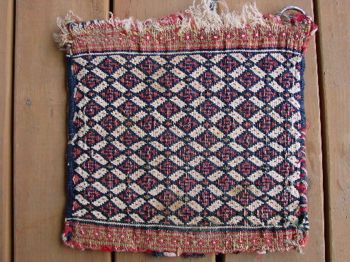
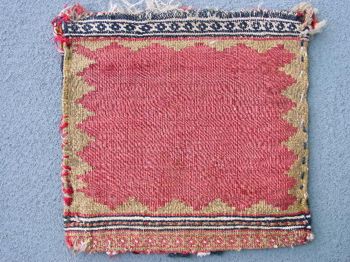
This example is 12 1/2" x 12 1/2", with z2s white wool warp, floating weft front and slit weave
(tapestry) back. Interestingly, it still retains a heavy steel ring, (there were probably two originally) sewn
into one corner for use in carrying the bag. The Qashqa'i bag above was woven without a closure system, as both
the front and back tops have been folded over and sewn.
On April 25, 1999, Marvin Amstey, on Turkotek, wrote:
"Closure systems. There are exceptions and variations, but generally neither Turkish nor Turkmen bags have
closure systems, while Persianate chanteh and khordjin (including Belouch) normally use a closure system of woven
slits to accommodate the loops. The closure systems for most Caucasian bags are cords that are attached so as to
permit closure without slits."
Thank you, Marvin. It is always comforting to have closure.
These first two pieces have the identical "S" shape in the middle of the "diamond lattice",
whereas the Black/Loveless pieces have an eight-pointed star, as does the flatwoven plate 101 in Brian MacDonald's,
Tribal Rugs, Treasures of the Black Tent. The flatweave piece has a crisper, more complete look, which raises
the question of whether the pile design was derived from the flatweave design. The Seljuk 14th century piece adds
a twist to the argument.
The chanteh holds a peculiar place in the pantheon of oriental rugs. It is the weaving most closely identified
with women, commonly known as a vanity bag, or purse for holding the jewelry or personal belongings of the women
of the family. Even though the chanteh is considered a woman's bag, James Opie, on page 104 of Tribal Rugs of
Southern Persia, says "I never saw a Khamseh or Qashqa'i woman carrying bags like this, although they,
or their men, would often bring rugs or other weavings into the Bazaar Vakil in Shiraz to sell."
I have seen many photographs of tribal women from the rug weaving areas and also do not recall having seen any
chanteh being carried by them, however their voluminous skirts could hide practically anything. Chapans or kurtehs
purportedly have no pockets, so chanteh would be tucked under the belt. As Henny Youngman might say, "Is that
a chanteh in your kurteh, or are you just happy to see me?"
The chanteh is generally accepted as any single bag smaller than a khorjin and without any other specific function
such as a spindle bag, water pipe bag, change purse or comb bag. You could call it the Cousin of the Khorjin.
Since it is the smallest of the woven bags, it is like the dessert to the main course, the trailer to the feature
film, the CD version of the album cover, the short guy on the basketball team, the Rodney Dangerfield "I don't
get no respect" of bags; it is the petit-four of rugs:
Pe.tit four: a small cake cut from pound or sponge cake and frosted
Pronunciation: "pe-tE='fOr
Etymology: French, literally, small oven
Date: 1884
Wendel Swan, in Salon 8 (Purse Your Tips),
wrote:
"Persian bags are used for innumerable purposes and we have many names for them: Khordjin, chanteh, mafrash,
chuval, toobreh, poshti and salt, to name but a few. They are found in a variety of structures (e.g. pile, kilim,
sumak, reverse sumak, extra weft knotted wrapping, mixed). But weaving traditions cross geographical and ethnic
borders. We find that a Turkish yastik is not terribly different from a Belouch balisht in form, function or size.
While these change purses are about the same size as many chanteh (single bag or pouch), we can readily see that
these bags were made and used for a specific purpose."
Thanks for the tips, Wendel!
The size of a chanteh is generally accepted to be anywhere from approximately 6" x 6" up to just
over 12" x 12". They were used to carry tea leaves, money, jewelry, even makeup or other small valuables.
This description is from Kilim, The Complete Guide, by Hull and Luczyc-Wyhowska: "Chanteh and Single
Bags (also known as canta in Turkey and chanta in the Caucasus; a kese is a Turkish money bag). This type of bag
has many different uses and may contain anything from personal adornments, a mirror, sewing and mending materials,
money, tobacco, writing materials and paper to a Koran."
Kordi, by Wilfried Stanzer, shows a small 11" x 12" bag called a "tobreh poshti", a
small shoulder bag for provisions and utensils, on page 199. He shows another 15" x 17" tobreh poshti,
"...used as a rucksack. Shepherds often stayed away from camp for days and kept their provisions in these
bags. Naturally, they could also have been used as transport for weak young animals."
During her recent trip to the USA, Elena Tsareva said these small bags were used to carry meat. I assume COOKED
meat! Roast a little goat over the fire for dinner and grab a leftover hunk for lunch when taking the herd out
for an afternoon of grazing! Toss in a few chunks of lamb chop for a picnic! Remember, the phrase "Paper or
plastic?" has not been around for very long and the ubiquitous tin lunch box was unknown in the Middle East,
not to mention plastic Power Ranger and Britney Spears lunch boxes.
The chanteh shown on page 69 of Opie's Tribal Rugs of Southern Persia has long tassles. Opie says "The
length of the tassels makes it an impractical bag to carry in hand. Presumably, it was hung from an animal during
migration and then from a pole or other support in the tent."
The chanteh has been thought to be part of a set of dowry weavings, which would include a khorjin and possibly
a saddle rug, salt bag and other weavings that a young woman would need to start her household. Some instances
of "matched sets" of these weavings have been found, such as that shown in Tribal Rugs, Treasures
of the Black Tent by Brian MacDonald (plate 124, on page 172). He shows a salt bag and a chanteh woven by the
Kurdish-Kaivanlu tribe of Khorassan province in the early 20th century. There is also a pair of salt bags and a
mafrash front panel (plates 48-49) in Woven Gardens by Black and Loveless, probably woven as part of a dowry
set. You are encouraged to post photographs of your sets of dowry weavings.
As with many types of weavings, the chanteh is found in many of the rug weaving cultures and is constructed with
many different methods. This multi-cultural existence may explain the lack of a reference book specifically devoted
to them.
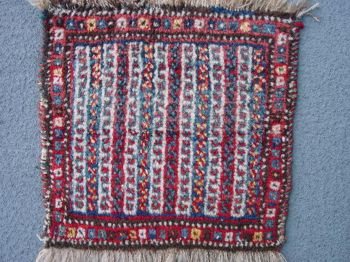
This is the first chanteh I bought, half a dozen years ago. I had admired it for a year or so on the wall of a dealer, but for the size it was quite expensive at several hundred dollars per square foot. The dealer was preparing to depart for a buying trip and lowered the price, almost as a challenge. I bought it. I had no idea how unusual it was until I began reading Marla Mallett's Woven Structures. I may have to donate it to Marla's Museum of Mixed-Up Marvels. For a simple and tiny pile weaving, it is the most complex and confusing weaving I have ever come across.
It is 11" wide x 10 1/2" high. It was attributed to the Afshar. It is a rather confounding piece, due to the complicated construction. It is almost as though the mother-in-law from one tribe was telling the girl to weave one way, the mother from a different tribe was telling her to weave another way, and she got so confused she wove every-which way! There are seven major colors, plus here and there in the centers of some of the squares in the border is an orange or a purple knot. In one square, there is a two-ply orange AND purple knot in the center! This chanteh has a design similar to the "cane" pattern, which can be seen in several Khamseh rugs in Opie's Tribal Rugs of Southern Persia (plates 91, 93 and 95). In The Splendor of Antique Rugs and Tapestries by Parviz Nemati, plate 128 shows an Afshar rug with this design. He says it is known as the Mohremati after the Mohremati shawls.
You will see that the small format of the chanteh has resulted in their designs being either a small portion of a larger repeating pattern found in the rugs of the weaving tribe, or a border pattern elaborated to fill the field of these smaller weavings.
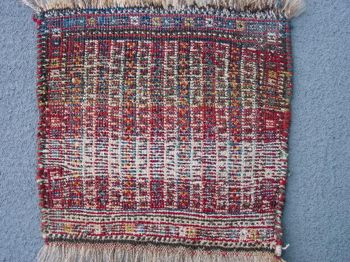
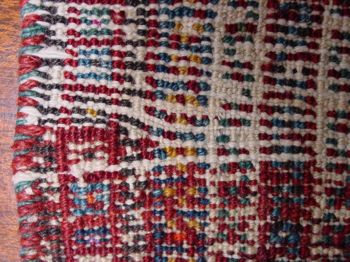
From this view of the back, you can see the truly mixed-up construction of this miniature marvel. The warp is white or brown/white wool. The selvages are a 4-part cord overcast alternately by the ground weft and two extra green and red selvage yarns for a multi-colored barber-pole effect. It has BOTH asymmetric open right AND symmetric knotting indiscriminately throughout. It has approximately 10 x 10 knots per inch, some of which are fully depressed, some moderately depressed and some flat. There are symmetric knots on some of the outer warps, some complete rows of symmetric and some of asymmetric knots. There are some intermixed rows of both knots.
The weft changes in color from two shots of blue and white in the top inch, to a couple of rows of dark brown
and white, an inch of red, two inches of gold and black, back to red, then 1 1/2" of white cotton, then red
and white, then white. There is also even a segment of discontinuous knotting and extra wefts near the bottom left,
visible as a "wedge". Speculation as to the reason for this multitude of methods, this cacophony of construction,
this mish-mash of a mess is eagerly solicited.
The Uzbek bag shown below was literally saturated with a gray, solid tar-like substance and reeked of tobacco.
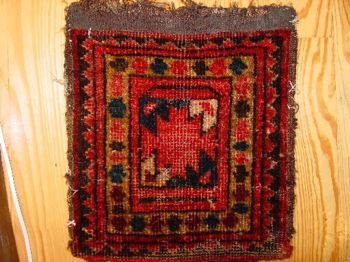
Steve Price, in a recent Show & Tell, wondered if tribesmen smoked tobacco in the 19th century. You will
find a photograph of several Bakhtiyari tribesmen smoking from a qaliay, or water pipe, on page 109 of Tribal
Rugs by Jenny Housego. She does not mention what they are smoking in that pipe.
From the website, www.Historian.org, comes this timeline:
1601: Turkey: Smoking is introduced, and rapidly takes hold while clerics denounce it. "Puffing in each other's faces, they made the streets and markets stink," writes historian Ibrahim Pecevi.
1624: Pope threatens excommunication for snuff users; sneezing is thought too close to sexual ecstasy
1628: Shah Sefi punishes two merchants for selling tobacco by pouring hot lead down their throat.
1633: Turkey: Sultan Murad IV orders tobacco users executed as infidels. As many as 18 a day were executed. Some historians consider the ban an anti-plague measure, some a fire-prevention measure
1647: Turkey: Tobacco ban is lifted. Pecevi writes that tobacco has now joined coffee, wine and opium as one of the four "cushions on the sofa of pleasure."
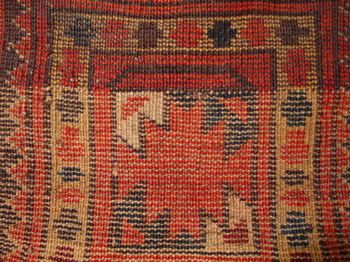
This little bagface is 11" wide x 12" high. It has asymmetric, open right knots, 7h x 10v, no warp depression. The warp is a dark, bristly goat hair. The top 1/3 of the weft is two shots dark - again probably goat hair, and the bottom 2/3 is lighter wool, readily seen from this photo of the back. There are six colors on this bag face and a light brown plain-weave back. There is no closure system and both front and back tops are folded over and sewn down.
It has an ashik lattice design, similar to that shown on Yomut asmalyks, reduced to a single design element to fit on this miniature weaving. It can be seen in another version in a Kizil Ayak panel in the Ersari section of the Antique Collectors' Club book, Volume 5 Turkoman, by Uwe Jourdan, and in several Yomut asmalyks in the same book (plates 189-192). There is a particularly nice version of this design in a Yomut asmalyk in Vanishing Jewels (plate 2). It is complete with tassles, and the caption says "It is uncommon to find asmalyks with the complete set of attached fringes and ropes at the top three points, which this one still retains." This Uzbek chanteh also has remnants of what would have been tassles at the bottom of the bag. You will notice that there is an arch at the top of the ashik motif that makes this chanteh look like a miniature prayer rug.
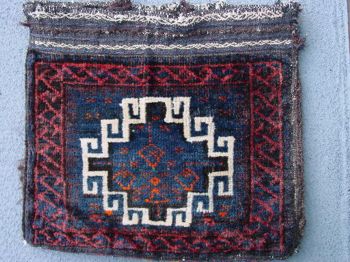
We are now traveling to Baluch territory with this Small, Dark and Handsome, swarthy piece. An article by
Dr. Dietrich Wegner appeared in Oriental Rug Review, July 1985, in which he says:
"The Balouch do not have any big oblong shaped tent bags as are common among Turkomans, who call them "djowall"
(juval) or "doshak". They neither have knotted spoon, comb, or mirror cases, nor the Turkomans "ok
bashi", a protective cap that is pulled over the ends of the bundled up tent poles. They make hardly any salt
containers, which are more frequent among the Tshahar (Chahar) Aimaq. They do make, however, small pile-woven bags
(chanteh) for multiple use. The bags have loops on the back side to pull a belt or a sholder strap through. Islamic
wandering monks in central and north Khorassan used them as purses."This Baluch chanteh is 15" wide x
13" tall. There were tassles along the bottom of this weaving at one time, indicating its use as a chanteh
rather than as half of a khorjin. The closure system consists of two sets of opposing goat-hair loops on the inside
of both the face and back of the bag. At the top of the bag, you can see the "back" of the goat-hair
closure-loop twining on the face of the bag between the two narrow two-color back-wrapped and bound borders found
above and below the white weft-substitution border stripes.
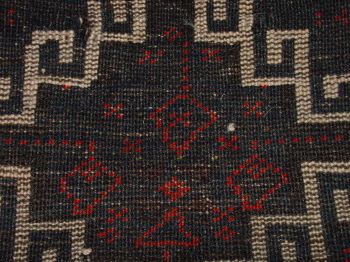
This bag has the Memling gul design, ubiquitous in Turkic iconography, piled in stark white relief against the lower, corroded field of a black outline inside the Memling gul and the even lower dark blue field. Highlights of a deep, dark red-orange make up a pointilist design of botehs, dice and hearts throughout the field. John Howe will be interested to know that there are three virtually invisible knots of green wool in the center of the face. One knot is directly below the bottom of the upper diamond-shaped boteh in the middle of the gul and the other two are 3/4" either side of the center knot of green. The warp is white wool, the weft is brown, possibly goat hair, two shots. The pile is asymmetric open left, no warp depression. As is common with Baluch weavings, the dark brown and dark blue and black are nearly indistinguishable at a glance. A further feature is the murkiness caused by the intermingling of these black, blue and brown knots in the main border, causing striations or waves of darkness within the maroon S-lattice border. This border is edged in the field with a reciprocal T surround, virtually imperceptible due to the darkness of the colors.
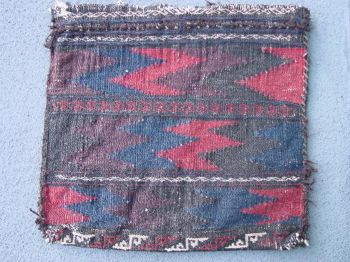
The back of this bag is a dovetailed tapestry weave interspersed with rows of two-color back-wrapped and bound borders divided by weft-substitution designs. The colors of brown, blue, red, maroon and black create an eye-dazzler pattern across the back.
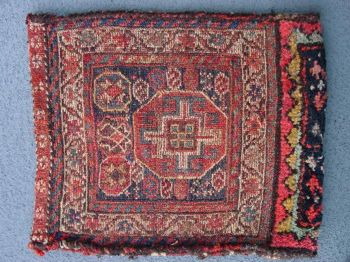
We shall now head into un-chanteh-d territory. The above bag is 12" wide x 15" tall. It has a countered soumak face with diagonal sumak outlining, a pile woven strip along the bottom and a plain woven back with weft substitution rosettes and bands of small weft float circles. The pile is symmetrical, with no warp depression, with a density of 5h x 7v knots for a staggering 35 knots per square inch! The pile design is a dark blue panel with X motifs having "birds head" ends, surrounded by a reciprocal red and green/yellow triangle border.
The Memling gul design and the meandering vine and flower border appear in Khamseh region NW Persian bags,
according to John Wertime, in Sumak Bags of Northwest Persia and Transcaucasia. However, the pile panel
at the bottom only shows up in a bag vaguely described as Northwest Persia with a possible relation to Rashvand
or Mafi weavings in Qazvin province, Lak or Kurdish, plate 136. There are two ground wefts between the rows of
sumak in this bag, too, another indicator of the Kurdish Rashvand or Mafi weavers of Qazvin. Wertime refers us
to plate 40 of the Jenny Housego book, Tribal Rugs, for a sumak khorjin with pile reinforcement attributed
to the Kurds of Qazvin. The rosettes at the top of the bag face, and in two rows on the back, are often an indicator
of weavings from the Veramin area, populated by Lurs, Afshars, Shahsavan, Kurds and others.
Please post photos of your bags with identical characteristics.
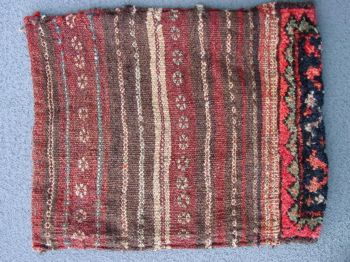
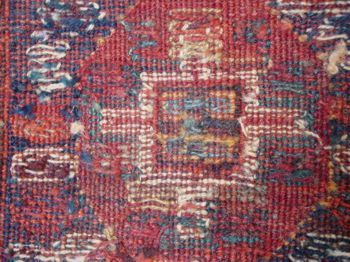
This next piece is a Lur chanteh from the SW Iran area, probably early 20th century. It, too, has a birds-head medallion, similar to the pile woven bottom strip of the bag above, but this one is more Lur in feel and design, with 12 arms instead of the four in the bag above. It has a 6h x 8v, 48 symmetrical knots per square inch, outclassing the previous bag by a huge one-third more knots per inch! It also has the row of triangle weft float designs shown in the previous bag. It is 13" wide by 12" tall, with 7 colors and quite a rustic, almost crude look, as opposed to the crisp, refined look of the Qashqa'i in figure #1.
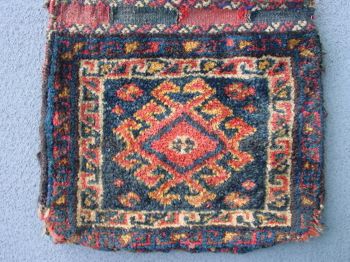
However, SURPRISE! It is NOT a chanteh, but a full-fledged Khorjin! Each face is approximately the size of a chanteh, but it is a complete set of bags. A bag this small would be fairly small for the average donkey, though. Perhaps it was for a child? Perhaps for a baby donkey?
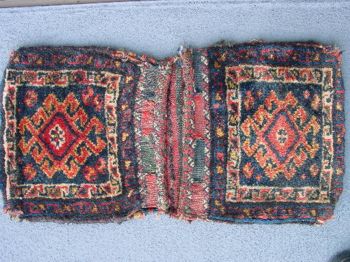
With the evidence in hand, of a khorjin with faces the same size as a chanteh, how many times have we been
fooled before? Careful examination, of the closure features especially, will provide clues. This khorjin uses the
slit-and-loop closures that would be difficult to eliminate unless the flatweave slits were worn entirely away.
Even cutting these bags apart and folding over the backs would leave telltale signs of the true function of these
bags. We can only assume that, unless contrary evidence is remaining, single bags of this size were most likely
chanteh.
Now, here is a bag with a size so diminutive as to almost preclude the possibility of it having been anything other
than a chanteh.
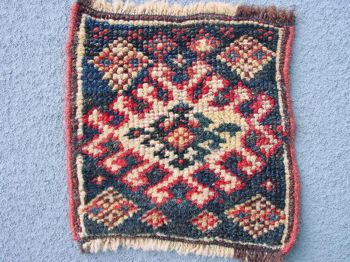
This little charmer is most assuredly a Lur weaving, with its bold, crude latchook medallion. It has no pretense of formality. Notice that the outermost arms of the medallion push their way into the meager border. The inner blue latchhook staggers to contain itself within the white field. Symmetry of design would only be evident from a distance too great to focus on the irregularities. But the overwhelming intensity of the lustrous natural dyes and the boldness of the impact this tiny treat possesses far exceed any lack of pretentiousness.
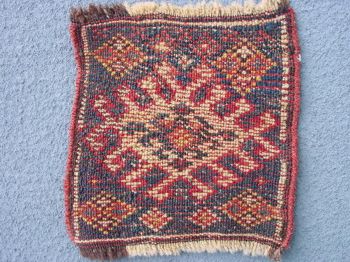
It is a mere 8" x 8" in size, with 7h x 8v, 46 symmetrical knots per square inch. It has a flat back and two shots of red weft. The design may be a single figure from a diamond lattice, or perhaps it is a protective spider-amulet with apotropaic power. For a related weaving, see the Lori (which is also red-wefted) in Opie, Tribal Rugs of Southern Persia (page 137). Small chanteh are supposed to have been made for children's use and for that reason are thought to be quite rare. I do not have any of the toys I played with as a child, so it is certainly understandable that things made for and used by children would have a relatively short lifespan.
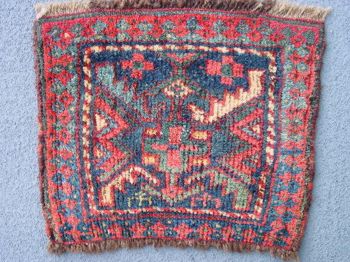
The bold and graphic chanteh shown above is most likely from the Basiri tribe of the Khamseh Federation of Southern Iran. The appealing design is a small section of the familiar medallion surrounded by fish design seen in so many of their bags, such as that shown in Opie's Tribal Rug of Southern Persia, page 109. Another khorjin with this design is plate 84 of Tribal Rugs by Brian MacDonald. He says it is a very stylized Herati pattern. A related example is shown here:
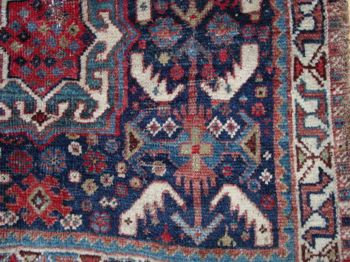
The back of this Chanteh shows the striations caused by the changing of the weft color from two shots of dark brown to two shots of red near the middle section. The warp is dark brown, except for a small area at each top corner, where a re-weave of damaged areas approximately 2 square inches on each side used light brown wool for the warps. It has been suggested that some restorers had used different-colored warps as an indicator that repairs had been made, and these repairs would not have been readily evident without the lighter colored warps so prominently visible. The pile is asymmetric, open right, 6h x 9v, 54 per square inch, moderately depressed. The selvage is two bundles of two warps overcast with maroon wool.
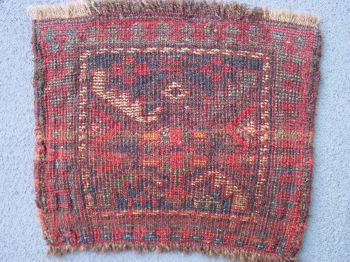
The final chapter in this study of chanteh is another Khamseh weaving, possibly from the mysterious and little known Nafar tribe. This attribution is probably speculative, owing to the paucity of weavings attributed to this small group. You will find a rug in Tribal Rugs, Treasures of the Black Tent, by Brian MacDonald (page 202, plate 146), attributed to: "the Nafar Turks, one of the three Turkic tribes within the "Confederacy of Five". The field design of that rug is similar to the device in the center of this chanteh:
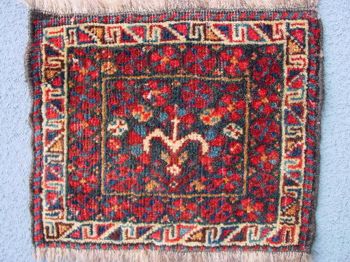
It is the same as this design from a finely woven Khamseh/Nafar rug:
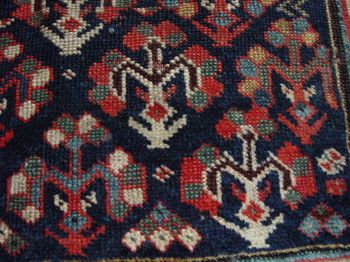
The central ornament looks a bit like a long-necked goose coming in for a landing, but the white "M" with the tall white stick with a cross at the top is really a floral device. The white part is the branches, and multi-colored, carnation-like flowers sprout from these branches. The back shows 10v x 11h asymmetric open left knots with moderate to severe warp depression. The weft is two shots of dark brown wool The selvage is 4 warps overcast with dark brown wool.
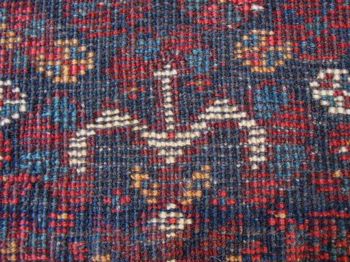
It may seem like there are a lot of weavings shown in this Salon, but if you add up the square footage, it would make up a rug a mere 2.5' wide x 4' long, hardly larger than a yastik or balisht. I would not recommend a collection of chanteh for anyone concerned about the price per square foot, since you could probably buy a nice full-pile 17th century Palace-Size Isphahan for less than this half-a-dozen chanteh. Well, maybe a late 18th century Karachoph Kazak. Well, maybe a room size Heriz. Well, maybe a basic Baluch throw rug. Well, maybe you could trade your threadbare Hamadan for a few of them.
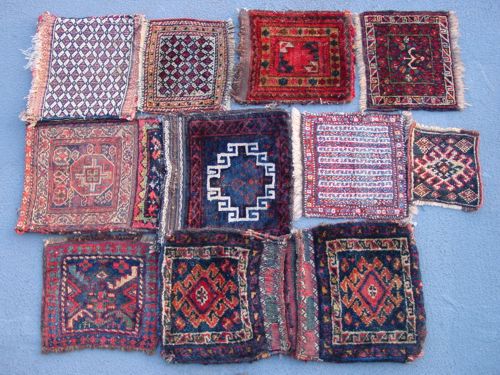
The references in this Salon to similar weavings are by no means exhaustive. The attributions are not conclusive,
only tentative. You are invited to post your examples of chanteh from other areas not covered, such as Anatolia
and the Caucasus, since it is well known that chanteh were woven in nearly every area with a weaving tradition.
Evidence contrary to the information presented is also welcome, as it is with the interplay of ideas and examples
that we all become more confident and knowledgeable in our ongoing study and collection of these beautiful anthropological
and ethnic textiles.
REFERENCES:
Good Cook's Book of Mustard, Michelle Anna Jordan
Woven Structures, Marla Mallett
Tribal Rugs, Jenny Housego
Tribal Rugs of Southern Persia, James Opie
Tribal Rugs, Treasures of the Black Tent, Brian MacDonald
Sumak Bags of Northwest Persia & Transcaucasia, John T. Wertime
Kordi, Wilfried Stanzer
Woven Gardens, Nomad and Village Rugs of the Fars Province of Southern Persia, Black and Loveless
Oriental Rugs. Volume 5, Turkoman, Uwe Jourdan
Vanishing Jewels, Central Asian Tribal Weavings. Exhibition of Weavings from the Collection of Marvin and Frederica Amstey, George O'Bannon
Oriental Rug Review, July 1985, Dietrich Wegner
Turkotek, Salon 8
Historian.org